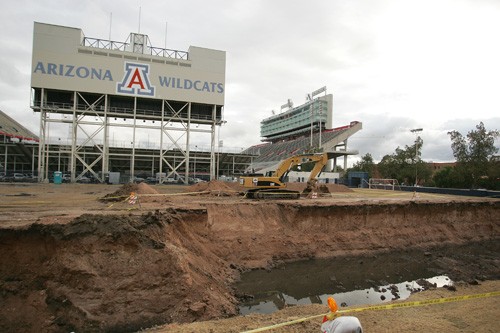PHOENIX — Arizona’s universities could upgrade their football stadiums and other athletic facilities using money from new local businesses, under a proposal moving through the State Legislature. The legislation is aimed mainly at Arizona State University’s Sun Devil Stadium, but the proposal could also raise cash for sports buildings at the UA and Northern Arizona University.
The heart of the proposal, sponsored by Rep. Warde Nichols, R-Gilbert, would let universities charge a fee on new businesses in a special district within the boundaries of each university.
The county Board of Supervisors would set up the districts upon an agreement with the Arizona Board of Regents.
Each university could then sell bonds to use for the construction or reconstruction of athletic facilities. The universities would set the fee, which could not exceed the cost of local property taxes.
Some lawmakers have expressed concern that that counties will lose money because businesses will choose to build within the university district to take advantage of a fee that is lower than local property taxes.
But since businesses on state land don’t pay a property tax now, Nichols said his bill would actually put businesses in the area on more equal footing.
The proposal would be a boon for ASU, which needs $170 million just to keep Sun Devil Stadium functioning, said Steve Nielsen, ASU’s assistant vice president of university real estate development.
But the UA might not gain much, even if lawmakers approve the bill.
While the UA supports the bill, it just doesn’t have enough businesses on campus to raise the kind of money needed for major projects, said Greg Fahey, the UA’s associate vice president for government relations.
“”Maybe in the future we could make use of it,”” Fahey said.
Nichols said this idea would help the universities fund projects they’ve said they need. But he acknowledged uncertainty about how much money the districts would raise for each school.
“”There is a certain aspect of guessing,”” Nichols said, adding that potential funds would hinge on the number of new businesses.
When the proposal was introduced last year, the Joint Legislative Budget Committee, which analyzes bills, estimated the maximum amount universities could make from the fee. According to a legislative summary of the bill, the committee found that ASU could generate $136,500 annually through its district. The UA, according to the analysis, could raise $94,600 each year.
The committee estimated that ASU would need to raise $13 million per year to cover the cost of borrowing for its stadium project.
The bill’s vagueness was one of the concerns raised by Rep. Andy Biggs, R-Gilbert, who voted against it in the House Ways and Means Committee last month.
“”I’m just trying to get you to admit there’s very little limitation,”” Biggs told Nichols during the committee hearing.
Nichols said the reason for the lack of restraints is that the universities know what they need.
Despite some concerns, the bill is poised for a House vote once it clears the Senate, although Nichols is expecting a battle there.
Meanwhile, the UA already has an almost $400 million blueprint to fix athletic facilities, Fahey said.
ABOR has approved a project with an estimated cost of about $90 million for Arizona Stadium, according to Steve Kozachik, the UA’s associate director of athletics, facilities and capital projects. Kozachik is also a member of the Tucson City Council.
The project will enclose the north end zone of the football stadium and allow for other enhancements, including upgrades to some seating areas. It is the first step in a long-term plan to fix athletic facilities, which includes renovations at McKale Center.
Kozachik said the UA is raising money for the stadium improvements, but it will have to come from donors to the athletic department, since the projects won’t get any state dollars.
And if Nichols’ proposal passes, the UA will take advantage of it, Kozachik said.
“”It would just be free money,”” he said
NAU is supportive of the bill, according to Christy Farley, the school’s associate vice president for governmental affairs and business partnerships. She said NAU doesn’t plan to use a stadium district immediately, mostly because NAU does not have enough development nearby to make it beneficial.
That’s not to say NAU does not want upgrades.
Although NAU Athletics does not technically own athletic facilities — they are tenants in certain facilities on campus — they could use improvements, athletic director Jim Fallis said.
The legislation is H.B. 2035.









